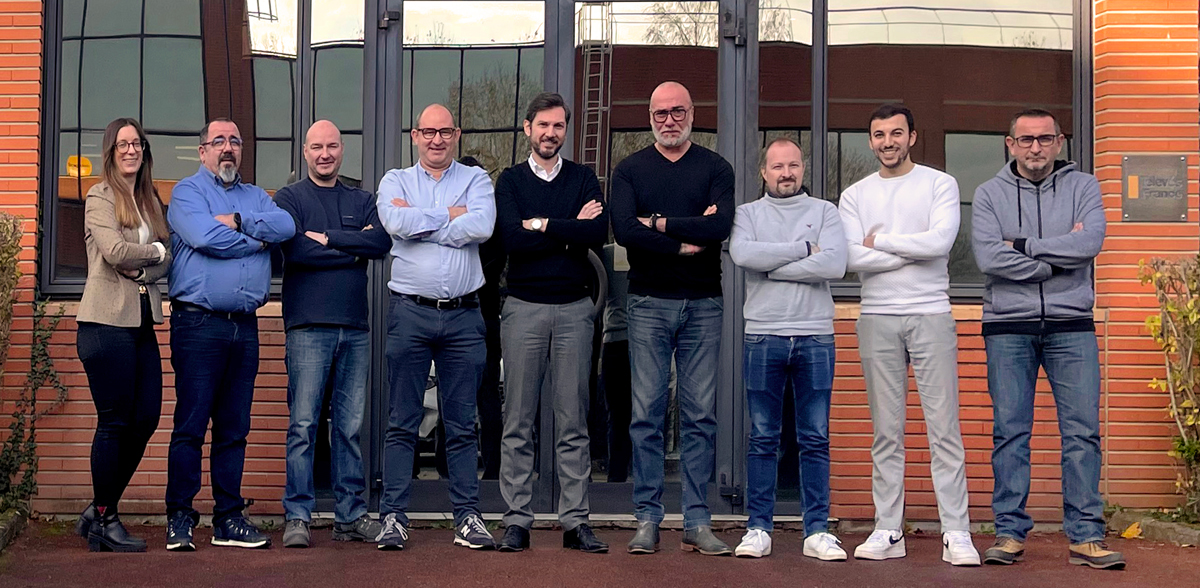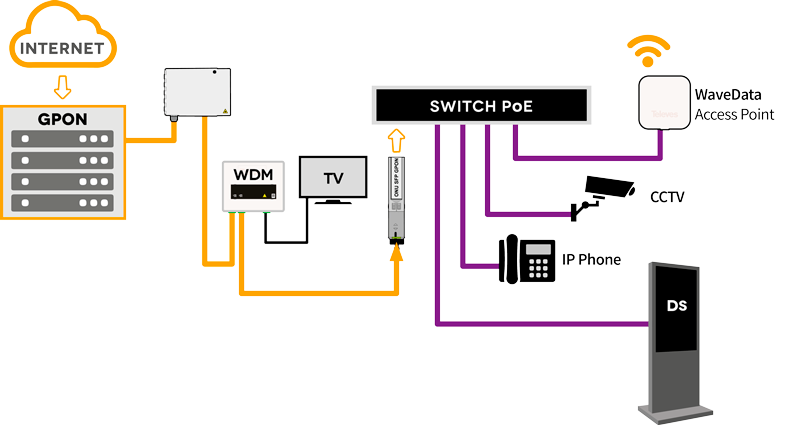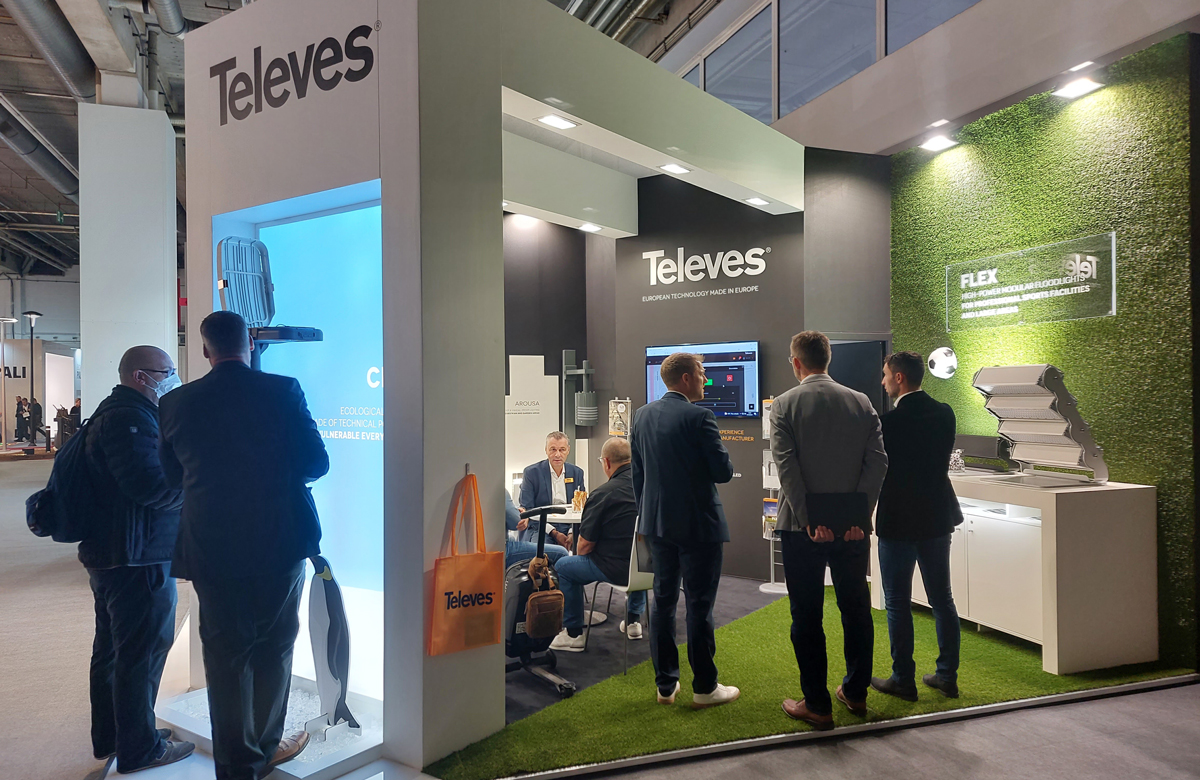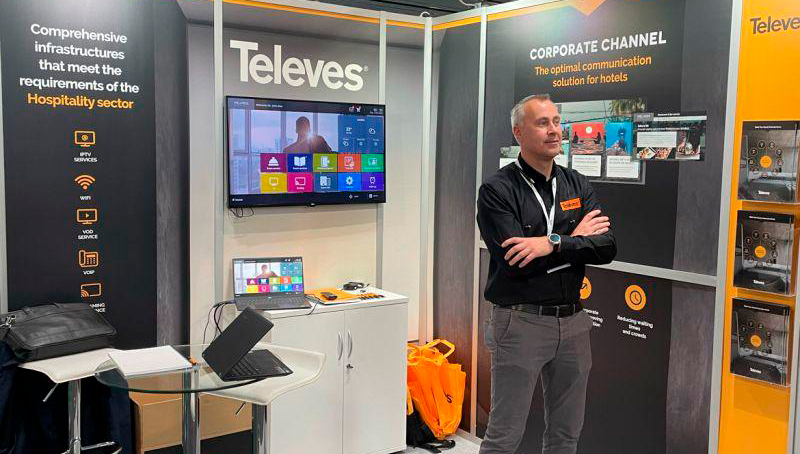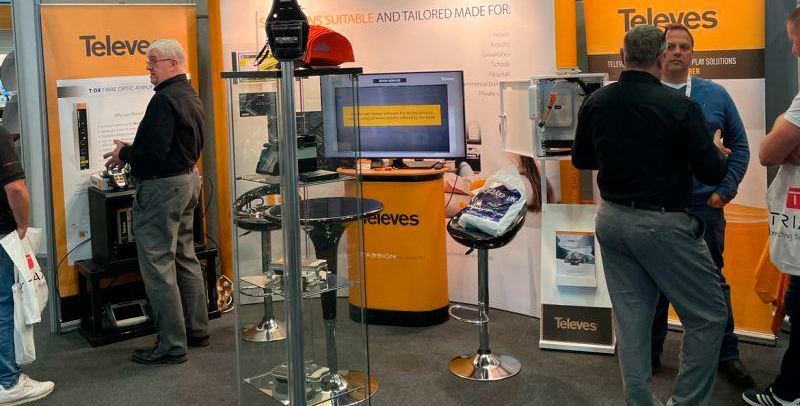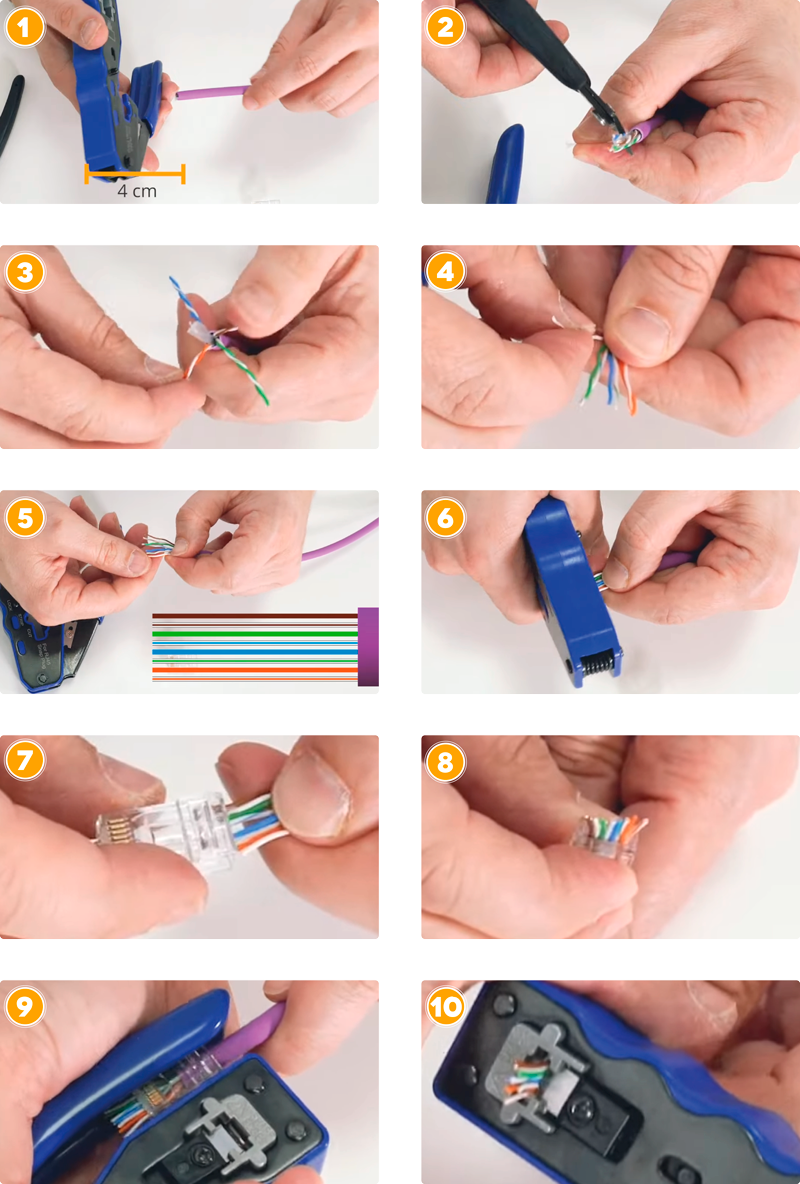Documentation
Complete and updated service and product documentation available for viewing and download. Select a category to begin your search.
InfoTeleves 65 (December)
- General Information: Televes France Celebrates its 25th Anniversary
- Our people: The important work of our branch office managers
- Televes Corporation: Javier Ruano, General Manager of Televes USA, is nominated for a seat on the ATSC’s Board of Directors
- Product news: SmartKom: Intelligent mast amplifier
- Ideas: How to build hybrid GPON-Ethernet networks using an SFP ONU
- FAQs: Single-mode or multi-mode fiber: Which one should you install?
- Televes facilities: Ciudad Deportiva de Armilla (Granada, Spain)
- Televes in the world: Light + Building, The Hotel Show, Expo COTELCO ...
- Training: Connector attachment for a CAT6 data cable with a pass‑through connector
- Announcement: H30 Crystal full, all features standard
General Information
Televes France Celebrates its 25th Anniversary
During the 4th quarter of this year we will be celebrating a major milestone, which reflects the internationalization strategy that Televes has been following for decades as an essential part of its growth: our affiliate in France was created on November 1, 1997.
Its first operating facility was leased at a business park in the commune of Pontault-Combault, just outside of Paris. Getting started was difficult, because we were introducing our eye-catching orange identity into a market dominated by white satellite dishes and black antennas.
The trend began to shift in December 1999, however, when France was hit by the storm of the century, which destroyed a huge number of antennas. This is when the value of having a manufacturer with its own logistics became clear. Televes France was able to ensure a daily supply of antennas for its distributors, and the market took notice of this.
As the affiliate’s success continued, and in view of the need to manage the upcoming analog broadcasting switchoff, its facilities were moved in 2004 to their current site in Saint-Thibault-des-Vignes, halfway between Paris and Disneyland. These facilities offered 2,500 m2 of floor space with a 1,750 m2 warehouse. After that, the focus shifted from selling antennas for households to the digital and HD markets for larger buildings, which allowed a move into a higher category and forging of prestigious alliances.
Televes France has evolved in parallel with that country’s various periods of technological upgrades, including the first digital dividend in 2013, the transition from MPEG2 to MPEG4 in 2016, and launching of the 700 MHz bandwidth from 2016 to 2019. The next major evolutionary step will be the upcoming transition in digital terrestrial television (DTT) to UltraHD and DVB-T2.
In France, Televes has now become much more than just a leading brand in distribution of TV services. Supported by the corporate group’s strength in offering TRedress transmission equipment and gap fillers, and thanks to its association with the company TDF, there are now more than 10 million households using our solutions to receive DTT channels. Currently the French affiliate is adapting its structure to prepare for its next evolutionary step, with the rolling out of network infrastructure for the Hospitality sector, along with smart LED lighting solutions and connections for indoor and outdoor lighting networks.
We would like to congratulate Televes France and its team for all of this outstanding growth achieved during the last 25 years, and we wish them another 25 years of remarkable success.
The value of a manufacturer with its own logistics became clear when France was hit by the storm of the century in 1999, which destroyed a huge number of antennas and satellite dishes.
Our people
The important work of our branch office managers
The most positive aspect is interaction with the customers, who we have developed close relationships with after so many years of collaboration
The people who manage our branch offices are an essential link between our commercial network and the organization. We recently spoke with Magdalena Jiménez from Madrid, Juan Martínez from Barcelona, and Alberto Caballero from the Canary Islands, to learn more about the work they do each day.
How would you describe your work at Televes?
Magdalena and Juan told us that their job consists of organizing the administrative tasks required for operation of their branch office, acting as a liaison with the head office, and providing day-to-day support for our salesforce and customers. This includes tracking orders, consultations, answering questions, and resolving any issues related to logistics or transportation.
For Alberto, his island location gives him the additional task of managing a logistics center, to ensure that the entire Canary Islands archipelago remains properly supplied.
How long have you been with the company? How would you describe your career so far?
Magdalena, Juan, and Alberto all joined Televes at about the same time, between 1990 and 1991. They were all able to take on additional responsibilities over time, in Juan’s case through decades of managing the northern and eastern zone warehouse, and for Magdalena and Alberto, by assisting previous managers with their work.
What is the most satisfying part of your job?
All three managers say that the most positive aspect is their interaction with the customers, who they have developed close relationships with after so many years of collaboration. They also emphasize their sense of belonging to a company with a culture of collaboration and teamwork, which is reflected in the way they are treated by their coworkers at their branch and at the head office.
What about the most difficult?
The managers say that they are most concerned by any inability to satisfy the needs of the customers. Alberto tells us that this may happen when several urgent matters come up all at once, or as Magdalena and Juan explain, when some problem beyond the company’s control arises, but they nevertheless have to take responsibility.
In your opinion, what are the company’s core values?
For Alberto, the value that sets Televes apart is its dedication to quality, innovation, and reliable service, while Magdalena says that the Televes brand is synonymous with design, innovation, and guaranteed quality. Juan also points out the high degree of professionalism among the personnel, which is a key aspect of the company’s outstanding customer service.
Televes Corporation
Javier Ruano, General Manager of Televes USA, is nominated for a seat on the ATSC’s Board of Directors
As the pace of the ATSC 3.0 rollout accelerates in the USA, television signal transmission operators must be able to adapt to an increasingly dynamic and efficient environment when managing and monitoring their DTT network infrastructure. The Advanced Television Systems Committee (ATSC) is an international non-profit organization that creates and promotes implementation of standards and best practices, to support advancement of DTT broadcasting and facilitate interoperability with other media.
On an annual basis, the ATSC elects new members for its Board of Directors, and this year Javier Ruano, Managing Director of our affiliate in the USA, has been nominated as a candidate to serve on that board for the next three years. Among other support, he has received a very valuable endorsement from Mark Aitken (a Senior VP at Sinclair Broadcast Group and President of ONE Media), who has been a member of the ATSC’s Board of Directors since 2020, and who has recognized Javier’s extensive international experience in over-the-air (OTA) markets and very mature SFN/OFDM environments. Over the course of his career, Javier has gained a deep understanding of the technology and market, including everything from the needs of broadcasters and the challenges they face, to the individual consumers who want to receive OTA signals.
The future of television is being defined with the next-generation ATSC 3.0 broadcasting standards, and here at Televes we hope that Javier Ruano will continue his involvement with this process, regardless of the final results of the board elections, because his experience in a variety of markets would be a catalyzing element for the organization in its strategy to internationalize those standards.
Product news
SmartKom: Intelligent mast amplifier
A single device that filters, mixes, amplifies and balances your TV distribution
In a TV installation, the use of amplifiers becomes virtually essential to be able to provide a quality signal level at the user's socket. However, this is not always an easy task. You have to filter the signal beforehand to avoid amplifying unwanted frequencies such as telephone frequencies, or when amplifying over a band, not all channels are balanced in signal level.
The new range of SmartKom amplifiers has been designed to solve the most common problems in this type of installation and to facilitate maintenance by the installer in family homes and small collective installations. Thus, with this amplifier the functions of filtering, mixing, amplification and signal balancing are combined under a single device, avoiding unnecessary signal losses due to connections and wiring between additional elements in the installation.
The incorporation of digital processing technology in these amplifiers allows filtering and level change of each channel separately thanks to the 32 programmable filters available. These filters have a high selectivity (up to 28dB rejection at 1MHz), so that even adjacent channels can be programmed.
As far as interference rejection is concerned, it also includes a powerful SAW filter to eliminate any 4G/5G telephony signals that may interfere with TV signals.
However, if there is one thing that is truly characteristic of these amplifiers, it is their intelligence. By simply pressing the self-programming button, the amplifier will analyze the received signals, program the 32 filters with the most important channels and adjust their levels to obtain the most complete and balanced output signal possible. All by itself, facilitating the installer's work.
In addition, more advanced professionals, who want to have full control of the configuration, can program the SmartKom amplifiers manually. This programming is conveniently done wirelessly, via Bluetooth, using a smartphone, tablet or PC, directly with the ASuite application.
This range of amplifiers is available in two formats:
- Mast version: it is installed as close to the antenna as possible, which provides better signal quality.
- Indoor version: designed to be combined with a multiswitch in a small collective installation.
In addition, if the SmartKom is combined with an Ellipse antenna, an unmatched signal quality is achieved.
Ideas
How to build hybrid GPON-Ethernet networks using an SFP ONU
GPON optical fiber networks allow for high-capacity, multi-service infrastructure (2.5Gbps/1.25Gbps). In addition to the optical fiber, the other two main elements of GPON architecture are the OLT headend and the ONT or ONU terminal elements, which can be of different types depending on the services offered (Wi-Fi, VoIP, TV overlay, etc.).
Our range of products includes a specific type of ONU known as an ONU SFP Adapter (Ref. 769520). It acts as an endpoint for the GPON network and an interface with the Ethernet switch, which is a traditional network element. When this ONU is plugged into one of the switch’s SFP ports, it allows for creation of hybrid networks with a GPON network core and a number of secondary points with Ethernet connectivity. In projects, its most typical application is installation in combination with PoE+ Ethernet switches, but it can also be used with any other type of network switch or element that has SFP ports. PoE switches allow Ethernet connectivity with up to 24 equipment elements that require PoE/PoE+ powering (up to 30W), which typically includes CCTV cameras, shared Wi-Fi hotspots, VoIP phones in offices, etc
FAQs
Single-mode or multi-mode fiber: Which one should you install?
The first aspect to consider is the technology being used by the system’s optical equipment (transmitter, receiver, etc.). Some devices are compatible only with particular fiber types, so there may be restrictions that will influence your decision on which type of fiber to use. However, if you have complete freedom to choose the fiber type, then we recommend taking into account the qualities offered by each of them:
- Single-mode (SM): because this type only transmits one light mode, there is less loss over long distances and also more bandwidth. Special lasers may have a higher cost.
- Multi-mode (MM): since more than one light mode is propagated, shorter distances are reached (up to approx. 2 km). However, the optical devices may cost less.
| Single-mode Fiber (SM) | Multi-mode Fiber (MM) | |
|---|---|---|
| Long distances | Laser cost | |
| Fiber cost | Fiber cost | |
| Laser cost | Long distances |
Currently, under the same conditions the two fiber types have a similar market price.
Based on these considerations, we recommend always choosing single-mode networks, not just in cases where the infrastructure must cover long distances. The reason for this is that although there is not much difference in cost right now, single-mode networks are more versatile and can be scaled up more easily later, without requiring additional spending to replace the equipment. This will create fewer restrictions on future expansion of the infrastructure, which is becoming increasingly common in applications that use optical networks for high-speed data transmission .
Televes facilities
Ciudad Deportiva de Armilla (Granada, Spain)
The Armilla Sports Complex is a multi-purpose sports and recreation facility, built in 1978 in the province of Granada, Spain. It features almost 20 hectares (50 acres) of space for all types of activities, even including spaces for lodging and restaurants.
The provincial government of Granada saw a need to upgrade the complex’s lighting using LED technology, to reduce its high energy consumption levels and address issues involving insufficient visibility. The visibility issues had worsened over the years, affecting all of the sports facilities including the field used for soccer, rugby, and field hockey, the padel and tennis courts, the indoor gymnasium, and the cycling track.
Urban light fixtures and LED projectors were installed during the upgrade’s various phases, along with Arousa beacons with customized silkscreening in the lodging areas. All of this lighting was professionally installed by the companies GIIT, OSEPSA, and Moimbra.
Televes in the world
Light + Building, The Hotel Show, Expo COTELCO ...
Light + Building (Frankfurt, Germany) June 27-30
In-person attendance has returned at the most important event in the lighting and building industry Televes attended this event for the first time, to showcase its smart, connected solutions. The featured product was our CIES ecological light fixture, manufactured using a high-tech polymer and 100% recyclable materials. Other featured products were the entire range with Zhaga-D4i certification and projectors for sports facilities.
The Hotel Show (Riyadh, Saudi Arabia) September 6-8
Televes participated in this event for the first time, where we showcased our network infrastructure solutions for connectivity and entertainment in hotels. Thsi included our ArantiaTV range, IPTV on-screen services and ArantiaCast, which lets users display their cell phone screen in their hotel room´s TV.
Expo COTELCO (Bogotá, Colombia) October 20-22
Our rapid expansion in the Latin American market is continuing. At this event, we demonstrated our Hospitality solutions, which give hotels the ability to offer their guests the best audiovisual and communication services, regardless of the type of network cabling or wireless infrastructure they have installed
Greencities & S-Moving 2022 (Málaga, Spain) September 21-22
An IoT node facilitates digitalization of a smart building, making this a key element for sustainable development of the cities of the future in a regulated, agreed-upon environment. José Luis Fernández Carnero had an opportunity to give a presentation focused on the need for an industry consensus that also addresses the need for regulation in this context.
International Hotel Show (London, UK) October 4-5
Televes has already become a fixture at this London event, where we always have an opportunity to explain the value of integrating all of the communication and audiovisual services provided to hotel guests, along with the hotel’s own control and management services, into a single ultrafast, sustainable network infrastructure.
Alltrade Trade Show (London, UK) October 6-7
Distribution of TV services continues to be a major focus in the UK market. Our affiliate there attended this event to present our latest new developments, with a special emphasis on fiber amplification in the T.0X format.
FEGIME Meeting Point (Madrid, Spain) October 9-20
This event presents an unparalleled opportunity for Televes to share with our customers the diversification taking place in our business areas, including everything from TV distribution to DataCom, Hospitality, professional LED lighting, and optical transport. Francisco Pérez, Ángel Álvarez, Hugo Botas, and Miguel Ángel Sánchez were all present at this year’s edition.
Training
Connector attachment for a CAT6 data cable with a pass‑through connector
A pass-through RJ45 connector is a quick and easy solution
In addition to the RJ45 data connectors standard in the market (ref. 209902), there is a new interesting solution as the pass-through data connector (ref. 209906).
One of the advantages of a pass-through connector is its simple attachment process, which has direct repercussions on assembly speed while also reducing connector attachment error rates. A crimping tool with automatic cutting (Ref. 209802) is required for attaching these connectors.
A Kit option (Ref. 209402) is also available for this connector type, which includes a carrying case, 150 pass-through connectors, a crimping tool, and 10 Velcro cable wraps.
Connector attachment time is reduced by eliminating the need for 100% alignment of the 4 pairs from the data cable in the connector’s slots. Cutting and alignment is performed at the end of the process, using the crimping tool with automatic aligned cutting.
 PROFESSIONAL CONNECTOR ATTACHMENT
PROFESSIONAL CONNECTOR ATTACHMENT
-
1
Use the crimping tool to strip the data cable (approx. 4 cm).
-
2
Cut the rip cord.
-
3
Separate the 4 pairs and trim back the plastic piece in the center of the data cable
(which provides rigidity and protection). -
4
Untwist each of the 4 pairs.
-
5
Straighten out the pairs and arrange them based on the TIA568Ao B color code.
This is the standard that defines how the 4 pairs must be arranged and attached to the connector’s pins (the A and B versions are both valid). -
6
Trim the ends of the pairs to make them easier to insert.
The advantage of using pass-through connectors is that there is no need to use special care at this point, because the 4 pairs will be perfectly aligned by using the crimping and cutting tool. -
7
Insert the cable into the connector until the 4 pairs are protruding out of the other side.
-
8
Make sure that the 4 pairs are correctly arranged and seated.
-
9
Apply some pressure with the crimping tool to improve the cable’s attachment.
-
10
Use the crimping tool to crimp the connection and trim the excess length of the 4 pairs.
Announcement
H30 Crystal full, all features standard


